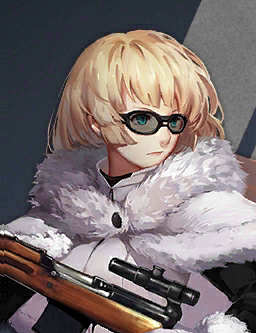Ranking of this Doll's specs relative to other Dolls of the same type.
SVT-38: Difference between revisions
mNo edit summary |
AutumnsFall (talk | contribs) No edit summary |
||
| Line 8: | Line 8: | ||
|manufacturer = Tula Arms Plant (or Tulsky Oruzheiny Zavod) | |manufacturer = Tula Arms Plant (or Tulsky Oruzheiny Zavod) | ||
|voiceactor = {{voice actor name|Ide Kaori}} | |voiceactor = {{voice actor name|Ide Kaori}} | ||
|fullname = Samozaryadnaya Vintovka Tokareva | |fullname = Samozaryadnaya Vintovka Tokareva 1938 | ||
|artist = {{artist name|sola7764}} | |artist = {{artist name|sola7764}} | ||
|releasedon = {{doll_server_alias|server=CN|alias=SVT-38}}, {{doll_server_alias|server=TW|alias=SVT-38}}, {{doll_server_alias|server=KR|alias=SVT-38}}, {{doll_server_alias|server=EN|alias=SVT-38}}, {{doll_server_alias|server=JP|alias=SVT-38}} | |releasedon = {{doll_server_alias|server=CN|alias=SVT-38}}, {{doll_server_alias|server=TW|alias=SVT-38}}, {{doll_server_alias|server=KR|alias=SVT-38}}, {{doll_server_alias|server=EN|alias=SVT-38}}, {{doll_server_alias|server=JP|alias=SVT-38}} | ||
| weaponinfo = The SVT-38 was equipped with a bayonet and a 10-round detachable magazine. The receiver was open-top, which enabled reloading of the magazine using five round Mosin–Nagant stripper clips. | |weaponinfo = | ||
The SVT-38 was a Soviet semi-automatic battle rifle designed by Fedor Tokarev. It was intended to be the Soviet Red Army's new service rifle, and to be the replacement for the Mosin-Nagant. A number of design issues would see the SVT-38 rifle dropped in favor of an improved version, the SVT-40. The SVT-40 would go on to see widespread use on the Eastern Front during the Second World War, although the German invasion of the Soviet Union in 1941 would prevent the SVT rifle from fully replacing the Mosin.<ref name = "svt wiki">[[wikipedia:SVT-40#SVT-38|Wikipedia entry on SVT-38]]</ref> | |||
Soviet leader Joseph Stalin had a great interest in semi-automatic infantry rifles, and wanted the Red Army to adopt a semi-automatic self-loading rifle to replace the aging Mosin-Nagant. To this end, the army would hold rifle trials beginning in 1935. Tokarev had been experimenting with self-loading rifles for some time, and had been focusing on recoil-operated designs. When these designs proved less than successful, Tokarev began pursuing a gas-operated design instead. He would submit his first version of the SVT to the 1935 rifle trials, where it competed against a number of other self-loading firearms. The winning rifle would be a design from Sergei Gavrilovich Simonov. This design was accepted into military service the next year as the AVS-36. However, problems with the AVS quickly became apparent, and both Tokarev and Simonov submitted improved designs to further trials. This time, Tokarev's rifle was accepted for production under the designation SVT-38, with hopes that it would become the new standard issue rifle of the Red Army. Ambitious production plans anticipated two million rifles per year by 1942. Production began at Tula Arsenal in July 1939, with production at Izhmash beginning later that same year. | |||
The SVT-38 is a gas-operated rifle with a short-stroke, spring-loaded piston above the barrel and a tilting bolt. This configuration would gain wider recognition years later, when Belgian firearms designer Dieudonné Saive used a similar operating mechanism in both the FN-49 and the FN FAL. Soviet small arms were usually of simple and robust construction, designed for use by poorly educated and sometimes poorly equipped soldiers. The SVT-38, in contrast, was a complex firearm by Soviet standards. It had been designed primarily with weight-saving in mind as opposed to simplicity, and featured a gas-cylinder cup that was not readily accessible. This proved to be a problem, as the weapon would require frequent cleaning due to the corrosively-primed ammunition in use by the Soviets. The SVT-38 was equipped with a bayonet and a 10-round detachable magazine. The receiver was open-top, which enabled reloading of the magazine using five round Mosin–Nagant stripper clips. Some of the rifle's features were fairly advanced for the time, such as the adjustable gas system, muzzle brake, and telescopic sight rails milled into the receiver. The sniper variant had an additional locking notch for a see-through scope mount, and was equipped with a 3.5× PU telescopic sight. This instrument was slightly shorter than the otherwise similar PU scope used on the Mosin–Nagant M1891/30 sniper rifle. | |||
The SVT-38 saw its combat debut in the 1939–1940 Winter War with Finland. The initial reaction of the troops to this new rifle was negative. Among the criticisms was that the rifle was too long and cumbersome, too difficult to maintain, and that the magazine had a tendency to fall out. Production of the SVT-38 was terminated in April 1940 after some 150,000 examples had been manufactured. An improved design, the SVT-40, would enter production in its place. It was a more refined, lighter design incorporating a modified folding magazine release. The hand guard was now of a one-piece construction, and the cleaning rod was now housed under the barrel. Other changes were made to simplify manufacturing. Production of the improved version began in July 1940 at Tula and later at factories in Izhevsk and Podolsk. Production of the Mosin–Nagant M1891/30 bolt-action rifle continued and it remained the standard-issue rifle to Red Army troops, with the SVT-40 more often issued to non-commissioned officers and elite units like the naval infantry. Since these factories already had experience manufacturing the SVT-38, output of the new pattern increased quickly, and an estimated 70,000 SVT-40s were produced in 1940 alone. Total production of the SVT-38/40 was around 1,600,000 rifles, of which 51,710 were the SVT-40 sniper variant. | |||
After the war, SVTs were mostly withdrawn from service and refurbished in arsenals, then stored. In Soviet service, firearms like the SKS and the AK-47 as well as the later SVD made the SVT obsolete, and the rifle was generally out of service by 1955. Only a few SVTs were exported to Soviet allies and clients. The Korean People's Army reportedly received some before the Korean War. The Finnish Army retired the SVT in 1958, and about 7,500 rifles were sold to the United States civilian market through firearm importer Interarms. This marked the end of SVTs in regular service. In the Soviet Union, some SVTs (without bayonets) were sold as civilian hunting rifles, although other SVTs were kept in storage until the 1990s, when many rifles were sold abroad, along with other surplus military firearms. Currently, the SVT is fairly widely available for collectors and historical enthusiasts, and is highly sought after. In Russia, limited examples for civilian use have been sold as the ОСК-88 (OSK 88) and Molot KO-SVT, with some variations in stock, barrel length, and optics. The rifle's popularity is due to a combination of the inexpensive nature of its 7.62×54mmR ammunition, favorable aesthetics, historical significance, and pleasant shooting characteristics. | |||
Despite its relatively brief service career, the SVT was a prolific rifle on the Eastern Front during World War II, and it had considerable impact on European battle rifle designs during and immediately after the war. The German G-43 was influenced by the SVT in its design, as was Simonov's experimental carbine developed during the closing stages of the war (which would later become the SKS). The FN FAL and its ancestor the FN-49 employ the same locking mechanism and operating principle as the SVT, although this is likely a coincidence. As a service rifle, the SVT had its problems, but so did other contemporary semi-automatic rifles made by other countries. The main reason for the gradual downfall of the SVT was not its technical disadvantages. Rather, the reason was that, with the immense, continual demand for rifles in the front lines, Soviet factories could produce other, simpler designs in far greater quantities in the same length of time it took to produce the SVT. | |||
|min_dmg= 43 | |min_dmg= 43 | ||
Revision as of 07:29, 5 November 2021
| SVT-38 | Story | Quotes |
SVT-38 40   | |
| Gun Information | |
|---|---|
| Full name | Samozaryadnaya Vintovka Tokareva 1938 |
| Country of origin | Soviet Union |
| Manufacturer | Tula Arms Plant (or Tulsky Oruzheiny Zavod) |
| Game Information | |
| Faction | Griffin & Kryuger |
| Manufactured / Revised by |
I.O.P. |
| Voice actor | Ide Kaori |
| Artist | sola7764 |
| Released on | CN, TW, KR, EN, JP |
| Chibi Animation | |
| Variant:
Click the marked area to switch between animations. For details regarding animations, please see Animations on the Wiki. | |
| View page template | |
How to obtain
NORMALHEAVY Timer 3:30:00. See T-Doll Production for details.
DROP Can be obtained from many battle stages from Chapter 3-3 onward.
REWARD Not obtained as a reward
Exclusive Equipment
Union Skill
There is no union skill for this T-Doll.
Stats / Data
| 42(x1) → 84(x1) / 420(x5) | 15(x1) / 55(x5) | 30(x1) / 90(x5) |
|
| ||||||||
|
| ||||||||
| 7 | 0 | ||||||||
| 40% | 50% | ||||||||
| 15 |
Ranking of this Doll's specs relative to every other Doll.
Weapon Background
The SVT-38 was a Soviet semi-automatic battle rifle designed by Fedor Tokarev. It was intended to be the Soviet Red Army's new service rifle, and to be the replacement for the Mosin-Nagant. A number of design issues would see the SVT-38 rifle dropped in favor of an improved version, the SVT-40. The SVT-40 would go on to see widespread use on the Eastern Front during the Second World War, although the German invasion of the Soviet Union in 1941 would prevent the SVT rifle from fully replacing the Mosin.[1]
Soviet leader Joseph Stalin had a great interest in semi-automatic infantry rifles, and wanted the Red Army to adopt a semi-automatic self-loading rifle to replace the aging Mosin-Nagant. To this end, the army would hold rifle trials beginning in 1935. Tokarev had been experimenting with self-loading rifles for some time, and had been focusing on recoil-operated designs. When these designs proved less than successful, Tokarev began pursuing a gas-operated design instead. He would submit his first version of the SVT to the 1935 rifle trials, where it competed against a number of other self-loading firearms. The winning rifle would be a design from Sergei Gavrilovich Simonov. This design was accepted into military service the next year as the AVS-36. However, problems with the AVS quickly became apparent, and both Tokarev and Simonov submitted improved designs to further trials. This time, Tokarev's rifle was accepted for production under the designation SVT-38, with hopes that it would become the new standard issue rifle of the Red Army. Ambitious production plans anticipated two million rifles per year by 1942. Production began at Tula Arsenal in July 1939, with production at Izhmash beginning later that same year.
The SVT-38 is a gas-operated rifle with a short-stroke, spring-loaded piston above the barrel and a tilting bolt. This configuration would gain wider recognition years later, when Belgian firearms designer Dieudonné Saive used a similar operating mechanism in both the FN-49 and the FN FAL. Soviet small arms were usually of simple and robust construction, designed for use by poorly educated and sometimes poorly equipped soldiers. The SVT-38, in contrast, was a complex firearm by Soviet standards. It had been designed primarily with weight-saving in mind as opposed to simplicity, and featured a gas-cylinder cup that was not readily accessible. This proved to be a problem, as the weapon would require frequent cleaning due to the corrosively-primed ammunition in use by the Soviets. The SVT-38 was equipped with a bayonet and a 10-round detachable magazine. The receiver was open-top, which enabled reloading of the magazine using five round Mosin–Nagant stripper clips. Some of the rifle's features were fairly advanced for the time, such as the adjustable gas system, muzzle brake, and telescopic sight rails milled into the receiver. The sniper variant had an additional locking notch for a see-through scope mount, and was equipped with a 3.5× PU telescopic sight. This instrument was slightly shorter than the otherwise similar PU scope used on the Mosin–Nagant M1891/30 sniper rifle.
The SVT-38 saw its combat debut in the 1939–1940 Winter War with Finland. The initial reaction of the troops to this new rifle was negative. Among the criticisms was that the rifle was too long and cumbersome, too difficult to maintain, and that the magazine had a tendency to fall out. Production of the SVT-38 was terminated in April 1940 after some 150,000 examples had been manufactured. An improved design, the SVT-40, would enter production in its place. It was a more refined, lighter design incorporating a modified folding magazine release. The hand guard was now of a one-piece construction, and the cleaning rod was now housed under the barrel. Other changes were made to simplify manufacturing. Production of the improved version began in July 1940 at Tula and later at factories in Izhevsk and Podolsk. Production of the Mosin–Nagant M1891/30 bolt-action rifle continued and it remained the standard-issue rifle to Red Army troops, with the SVT-40 more often issued to non-commissioned officers and elite units like the naval infantry. Since these factories already had experience manufacturing the SVT-38, output of the new pattern increased quickly, and an estimated 70,000 SVT-40s were produced in 1940 alone. Total production of the SVT-38/40 was around 1,600,000 rifles, of which 51,710 were the SVT-40 sniper variant.
After the war, SVTs were mostly withdrawn from service and refurbished in arsenals, then stored. In Soviet service, firearms like the SKS and the AK-47 as well as the later SVD made the SVT obsolete, and the rifle was generally out of service by 1955. Only a few SVTs were exported to Soviet allies and clients. The Korean People's Army reportedly received some before the Korean War. The Finnish Army retired the SVT in 1958, and about 7,500 rifles were sold to the United States civilian market through firearm importer Interarms. This marked the end of SVTs in regular service. In the Soviet Union, some SVTs (without bayonets) were sold as civilian hunting rifles, although other SVTs were kept in storage until the 1990s, when many rifles were sold abroad, along with other surplus military firearms. Currently, the SVT is fairly widely available for collectors and historical enthusiasts, and is highly sought after. In Russia, limited examples for civilian use have been sold as the ОСК-88 (OSK 88) and Molot KO-SVT, with some variations in stock, barrel length, and optics. The rifle's popularity is due to a combination of the inexpensive nature of its 7.62×54mmR ammunition, favorable aesthetics, historical significance, and pleasant shooting characteristics.
Despite its relatively brief service career, the SVT was a prolific rifle on the Eastern Front during World War II, and it had considerable impact on European battle rifle designs during and immediately after the war. The German G-43 was influenced by the SVT in its design, as was Simonov's experimental carbine developed during the closing stages of the war (which would later become the SKS). The FN FAL and its ancestor the FN-49 employ the same locking mechanism and operating principle as the SVT, although this is likely a coincidence. As a service rifle, the SVT had its problems, but so did other contemporary semi-automatic rifles made by other countries. The main reason for the gradual downfall of the SVT was not its technical disadvantages. Rather, the reason was that, with the immense, continual demand for rifles in the front lines, Soviet factories could produce other, simpler designs in far greater quantities in the same length of time it took to produce the SVT.
Gallery
Main artwork
Gallery consisting of artworks used primarily in-game. For information on how to obtain certain costumes, see Skin Catalogue.
-
Profile image
-
Full artwork
-
Full damaged artwork
Alternative artwork
Alternate gallery consisting of artworks with slight alterations as well as miscellaneous artworks.
-
Full damaged artwork (Censored)
References
| List of T-Dolls |
|---|


















